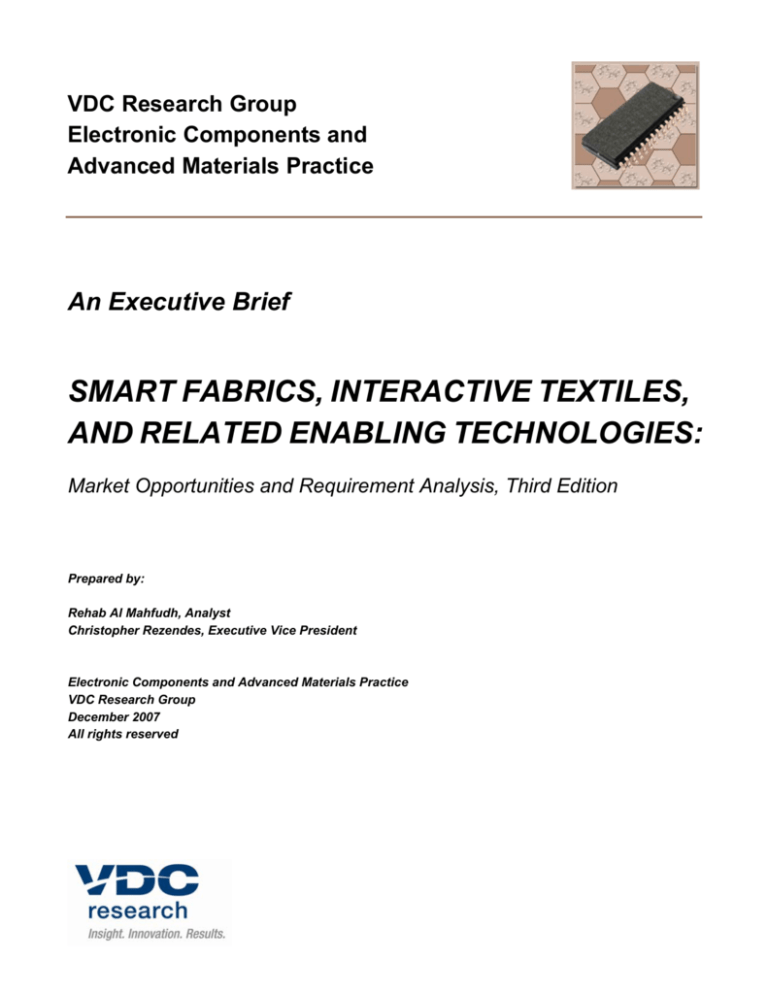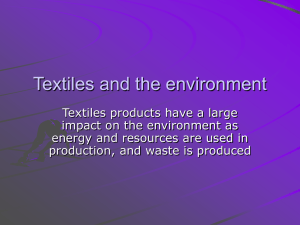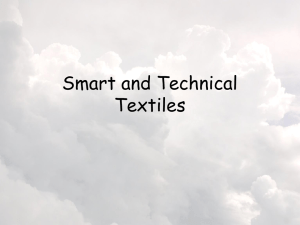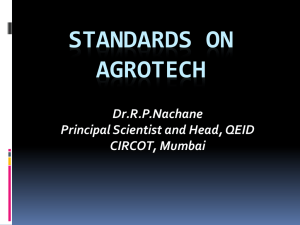
VDC Research Group
Electronic Components and
Advanced Materials Practice
An Executive Brief
SMART FABRICS, INTERACTIVE TEXTILES,
AND RELATED ENABLING TECHNOLOGIES:
Market Opportunities and Requirement Analysis, Third Edition
Prepared by:
Rehab Al Mahfudh, Analyst
Christopher Rezendes, Executive Vice President
Electronic Components and Advanced Materials Practice
VDC Research Group
December 2007
All rights reserved
An Executive Brief, SMART FABRICS, INTERACTIVE TEXTILES, AND RELATED ENABLING TECHNOLOGIES
1
The following executive brief presents top-level findings from VDC’s recently released report, Smart
Fabrics, Interactive Textiles, and Related Enabling Technologies: Market Opportunities and
Requirements Analysis, Third Edition.
Smart Fabrics and Interactive Textiles – SFIT
Smart fabrics and interactive textiles are fabrics or textiles that react to the environment or to stimuli from
electrical, mechanical, thermal, chemical, or magnetic sources. These reactions provide an intelligent
environment in one of two ways:
1. Conducting, transferring, or distributing properties, such as:
–
Electrical Current
–
Light Energy
–
Molecular or Particulate Matter
–
Thermal Energy
2. Changing physical characteristics or phase, such as:
–
Color
–
Permeability
–
Porosity
–
Rigidity
–
Shape
–
Size
Electronic devices and technologies are integrated into the fabric or textiles. The resulting system can
provide advanced useful features to the consumer, such as: safety, comfort, convenience, fashion, and
mobility. Features provided to industrial applications and business operations include: improved
efficiency, better functionality, and lighter weight.
SFIT Technical Value Chain
SFIT final solutions undergo a number of development stages and incorporate a unique blend of
materials and technologies, in order to reach their final commercial form.
SFIT Enabling
Technologies:
Advanced Materials &
Components
SFIT-Based
Modules:
Smart Fabrics
& Interactive
Textiles
SFIT Final
Solution
© 2007 VDC Research Group, Inc.
An Executive Brief, SMART FABRICS, INTERACTIVE TEXTILES, AND RELATED ENABLING TECHNOLOGIES
2
SFIT Enabling Technologies: Include enabling materials and enabling components.
Enabling Materials
Enabling materials are advanced elements or chemical structures used to treat or coat fibers, threads and
yarns. These materials represent the enabling element, and are a prerequisite for all SFIT final solutions.
Enabling materials include metals, silver nanocomposites, ceramics, and iron oxide.
Enabling Components
•
SFIT enabling components are the platform that enables smart functionality to the fabric or
textile. SFIT enabling components include electronic components and fabric components.
Electronic Components: Electronic components are discrete electronics that are externally applied. SFIT
functionality can be provided by adding and implementing external devices. Examples include:
•
Data processing (CPU, MPU, DSP, MCU)
•
Power supply (photovoltaics, batteries, micro batteries, fuel cells)
•
Input/output devices (sensors, accelerometers, touch pads, keyboards)
•
Display (LED, Electroluminescent lighting, fiber optics)
•
Data communication (LAN, WAN)
Fabric Components: Fabric components are the fibers, filaments, films, and other beginning stages of a
textile. Fabric components are manufactured into the fabric or textile in several different ways. Fabrics
may be woven or non-woven via adhesive or thermal bonding, tufting, felting, or mechanical interlock.
The result is a fabric or textile structure within which resides (or upon which rests) the SFIT enabling
element.
SFIT-Based Modules: In this level of the SFIT technical chain, the matrix that comprises the SFIT
solution is assembled. SFIT-based modules are the smart fabrics or the interactive textiles. They can take
many forms, such as:
•
Non-woven fabric, which is a matrix of fibers, thermally or adhesively bonded
•
Woven and knit fabric
•
Conductive thread sewn into a fabric
•
Conductive polymer woven into the fabric
Example: Carbotex Seat-heating technology
Catobtex technology, developed by W.E.T Automotive Systems Ltd, is a combination of insulated copper
wiring and carbon fiber material. Carbotex is durable, thin, and soft, which makes the process of sewing it
into leather and cloth easier.
© 2007 VDC Research Group, Inc.
An Executive Brief, SMART FABRICS, INTERACTIVE TEXTILES, AND RELATED ENABLING TECHNOLOGIES
3
Example: ElekTex technology
ElekTex has two outer layers of conductive textiles; these conductive layers are separated by a partially
conductive layer. The inner layer conducts when pressure is applied, and by doing so, connecting the two
outer layers. The drop in resistance that results from the applied pressure causes a voltage differential
that can be measured at the edges of the outer layers; the amount as well as the location of the pressure
can be measured. ElekTex is Eleksen’s core technology, and it is incorporated into the ElekTex Bluetooth
fabric keyboard.
SFIT Complete Solutions: This is the final marketable form the SFIT solution takes. These solutions
incorporate several of the previously mentioned SFIT technologies. Examples of SFIT final solutions
include:
•
Accessories (hat, helmets, gloves, textile cables)
•
Building Materials (structural support, warming)
•
Clothing (jackets, shirts, shoes, vests, bras)
•
Durables (blankets, seat covers, tents)
Example: Rosner’s multimedia lifestyle jacket
The jacket enables mobile phoning via Bluetooth, an mp3 player is also built inside the jacket. The wearer
can control the electronic system by the buttons on the jacket’s sleeve.
Example: MET5 Jacket
The MET5 jacket developed by North face utilizes Polartec HeatTM, a fabric technology developed by
Malden Mills. The jacket has heated panels that are activated and controlled by the user.
Example: Burton Amp Smart Ski and Snowboard Jacket
Through a partnership between Burton Snowboards and Apple, the Amp Smart Ski and Snowboard
Jacket was introduced. Using Softswitch technology, the jacket has a fabric-based keypad on the sleeve.
This keypad controls an integrated iPod from Apple. The soft keys on the mounted on the sleeve allow
the wearer to adjust song tracks and volume.
© 2007 VDC Research Group, Inc.
An Executive Brief, SMART FABRICS, INTERACTIVE TEXTILES, AND RELATED ENABLING TECHNOLOGIES
4
SFIT Commercial Value Chain
Exhibit 1
Commercial Value Chain
Research and Development Institutions
SFIT Enabling Technologies Suppliers
(Advanced Materials & Components)
Processing
SFIT Based Module Suppliers
Smart Fabrics and Interactive Textiles
Assembly
SFIT Application Suppliers
Actuation &
Response
Computing &
Communication
Heat & Energy
Management
Location &
Position
Lighting
Sense &
Monitor
End Users
Industrial/
Commercial
Government/
Military
Medical/
Health
Consumer/
Retail
Transportation
SFIT MARKET DRIVERS AND INHIBITORS
Market Drivers
Market Awareness: There is ample interest from the general public in SFIT products; media sources help
generate a lot of buzz. Some SFIT final solutions received extensive coverage from high-profile media
sources. All of this helped create an atmosphere of enthusiasm and excitement. Many companies have
capitalized on this situation; relying on media coverage, industry trade shows, conferences, and featured
articles as a substitute for pricey marketing campaigns.
Partnerships and Collaboration: Industry partnerships are playing an increasingly important
developmental role. For many firms, participation in the SFIT industry was facilitated, and only became
possible through partnerships. This has enabled a network of supporting industries, and has led to the
emergence of SFIT final solutions within various applications.
© 2007 VDC Research Group, Inc.
An Executive Brief, SMART FABRICS, INTERACTIVE TEXTILES, AND RELATED ENABLING TECHNOLOGIES
5
Funding and Investments: Patents have helped firms recover a portion of their R&D expenses. SFIT
suppliers vary in their funding strategies; some rely on venture funds, while others are more fiscally
conservative and fully dependent on retained earnings. Several SFIT vendors sell non-SFIT products, or
are engaged in non-SFIT project work for client companies. Revenue generated from these non-SFIT
sources is a reliable cash flow, and has been used by these companies to fund SFIT R&D.
OEM Knowledge / Demand: Most SFIT suppliers that develop SFIT modules and/or solutions suggested
apparent improvements over the last couple of years in OEM knowledge of their technologies and
offerings, and thus higher OEM demand. Some went further to say that OEMs are creating demand for
the whole industry.
Competitive Environment: The SFIT industry has not yet moved into fierce competition. Each participant
in this market has carved out its own corner, and found its own niche. Naturally, as demand picks up so
will competition.
SFIT enabling technologies suppliers pushing strategies and SFIT solution suppliers pulling strategies:
Initially, SFIT suppliers adopted a pushing strategy to push their technologies on the market. However,
after incurring high costs in developing and marketing a less than desirable technology, some SFIT
suppliers abandoned their pushing strategies for SFIT enabling technologies and modules.
In an attempt to improve efficiency and thus profitability, SFIT suppliers have started to research a market
area before entering; seeking markets with an already established need. SFIT suppliers also constantly
listen to their clients, and tailor their SFIT products based on their needs.
Market Inhibitors:
Commercial Prices: Today, high commercial prices represent the largest barrier to wide-scale market
penetration. Economies of scale and efficient manufacturing practices have not been achieved yet;
therefore, high margins are demanded on SFIT products and solutions.
Safety: One pressing issue when it comes to safety standards is the significant variation from one country
to another on what is acceptable, and the minimum safety levels required. This causes a lot of confusion,
and may increase perceptions of unsafe SFIT technologies that have no scientific base, or are
exaggerated.
Lack of Standards: There is a lack of common standards and practices in the SFIT industry; this seems to
be generating frustration and confusion across the industry. There is no defined body that has been
delegated the task of setting the standards for the SFIT industry. Therefore, there is a vital need today for
a common body or consortium to emerge and lead the way in defining these standards. This common
body should consist of SFIT participants from each and every level of the technical and commercial value
chains.
Performance / functions / features: SFIT products and solutions have improved over the last couple of
years in terms of functionality and performance. The electronic components are more integrated and the
technology is more robust.
© 2007 VDC Research Group, Inc.
An Executive Brief, SMART FABRICS, INTERACTIVE TEXTILES, AND RELATED ENABLING TECHNOLOGIES
6
User skepticism / Demand: In an area where people do not really know the possibilities; much needs to
be done. First users need to be shown the fully working system, and then feedback needs to be
collected, and alterations made to the system based on this feedback. SFIT solutions can then be
developed to better meet consumers’ needs, habits, and tastes.
SFIT Market Analysis
SFIT Market Size and Growth
Growth will pick up at a faster pace in comparison with the last five years, VDC estimates the compound
annual growth rate (CAGR) for 2006-2010 five-year horizon to be 32%. This increase in revenues will
help provide for further R&D funding; in addition, SFIT participants will be able to expand the scope of
their products, and ultimately achieve efficiencies in manufacturing, and cost savings in production.
Exhibit 2
Forecasted Total SFIT Sales for 2006 – 2010 Segmented by Function
(Millions of Dollars)
Conduct/Distribute Electrical Current
Conduct/Distribute Light Energy
Conduct/Distribute Thermal Energy
Transfer/Distribute Matter
Total
Base Year 2006
141.6
71.4
155.5
0.7
369.2
Forecast 2010
706.1
160.9
258.4
4.1
1129.5
CAGR 2006-2010
49.4%
22.5%
13.5%
55.9%
32.3%
Potential SFIT Suppliers
Specialty chemical companies, nanotechnologies suppliers, and high-performance fabrics and textiles
suppliers, which have no involvement in the SFIT industry yet, showed different levels of interest for
potential SFIT offerings. Some are actively watching SFIT developments and have set benchmarks that
need to be met before they do support SFIT offerings, while others expressed lower levels of interest.
SFIT Research and Development
Much SFIT-related research is being pursued, mainly from academic institutions, government agencies,
and industry participants. Scholastic research at academic institutions represents the majority of all SFIT
research activities. Alliances are commonplace among research bodies and funding sources; government
agencies have funded SFIT research at academic institutions, and academic institutions have formed
alliances and worked on research projects with SFIT industry participants.
OEM Analysis
OEMs will act only upon existing demand from consumers; however, when demand is sensed, OEMs
spend a lot of resource to seek out the best SFIT technologies available. OEMs are receptive to
technology push strategies, often perused by SFIT vendors, in cases where SFIT vendors are able to
show compelling evidence of existing consumer demand. Furthermore, SFIT vendor strategies of
assisting OEMs in various ways, from tailored products to co-branding seem to act as an incentive for
OEMs to be more open and receptive to SFIT technologies.
© 2007 VDC Research Group, Inc.
An Executive Brief, SMART FABRICS, INTERACTIVE TEXTILES, AND RELATED ENABLING TECHNOLOGIES
7
SFIT Industry Trends – Vertical Integration
Vertical integration is quite a common trend in the SFIT industry; most of it is happening among the
suppliers of SFIT-based modules and final solutions. Vertical integration is mostly beneficial in SFIT
consumer softgood markets, with the integration trend expected to increase in this market. The primary
driver of this strategy is necessity; accelerated SFIT market development is requiring that suppliers go to
market with integrated solutions.
Evolution of Partnerships
Each and every SFIT final solution represents an amalgamation of elements, components, and
technologies from various industries. Capacity limitation and scarce resources have led many SFIT firms
to enter into strategic alliances. SFIT participants have sought to share financial and operational risks,
and to achieve mutual benefits. Through strategic alliances, SFIT firms have been able to pool their
resources and complement their capabilities.
SFIT Competitive Advantage Source and Sustainability
A competitive advantage can be achieved and sustained in the SFIT industry from the following sources:
1. Innovation
2. Manufacturing and Marketing
3. Dominant Design and Standards
These three sources of competitive advantage are interrelated. Given the threat of competitors imitating a
technology, firms tend to invest in manufacturing and marketing, which will help their innovation become
the industry’s dominant design, and will set industry standards. To the same extent, firms with excellent
manufacturing techniques and effective marketing strategies, but are not innovative and do not own any
patents, will be at a competitive disadvantage.
© 2007 VDC Research Group, Inc.
An Executive Brief, SMART FABRICS, INTERACTIVE TEXTILES, AND RELATED ENABLING TECHNOLOGIES
8
ABOUT THE STUDY
VDC Research Group recently released the new research report, Smart Fabrics, Interactive Textiles, and
Related Enabling Technologies: Market Opportunities and Requirements Analysis. This is VDC’s third
publication assessing the SFIT market. The report covers the global market opportunity for the
consumption of products that incorporate SFIT technologies.
Product Offering / Technology
Product Segmentation
•
Conduct/distribute electrical current
•
SFIT Enabling Technologies
•
Conduct/distribute light energy
•
SFIT-Based Modules
•
Conduct/distribute thermal energy
•
SFIT Application
•
Conduct/distribute matter
Vertical Segmentation
Application Segmentation
•
Industrial /Commercial
•
Actuation and Response
•
Government /Military
•
Computing and Communication
•
Medical /Health
•
Heat and Energy Management
•
Consumer /Retail
•
Location and Position
•
Transportation
•
Lighting
•
Sense and Monitor
ABOUT VDC
VDC Research Group (VDC) is an independent technology market research and strategy consulting firm
that specializes in a number of components, mobile & wireless, industrial, embedded, defense and niche
enterprise IT markets. VDC has been operating since 1971, when graduates of the Harvard Business
School and Massachusetts Institute of Technology founded the firm. Today, we employ a talented
collection of analysts and consultants who offer a rare combination of expertise in the market research
process; experience in technology product and program management, and formal training in engineering
and marketing. VDC’s clients include thousands of the largest and fastest-growing tech suppliers in the
world and the most successful investors participating in the markets we cover.
For further information about, Smart Fabrics, Interactive Textiles, and Related Enabling Technologies:
Market Opportunities and Requirement Analysis Third Edition contact:
Chris Rezendes, Vice President, 508.653.9000, Ext. 120, cjr@vdcresearch.com
For purchasing information, contact:
Gerrald Smith, Account Executive, 508.653.9000 ext. 113, gsmith@vdcresearch.com
VDC RESEARCH GROUP, INC.
679 Worcester Road | Suite 2 | Natick, MA 01760 | USA
T: 508.653.9000 | F: 508.653.9836 | E: info@vdcresearch.com | W: www.vdcresearch.com







